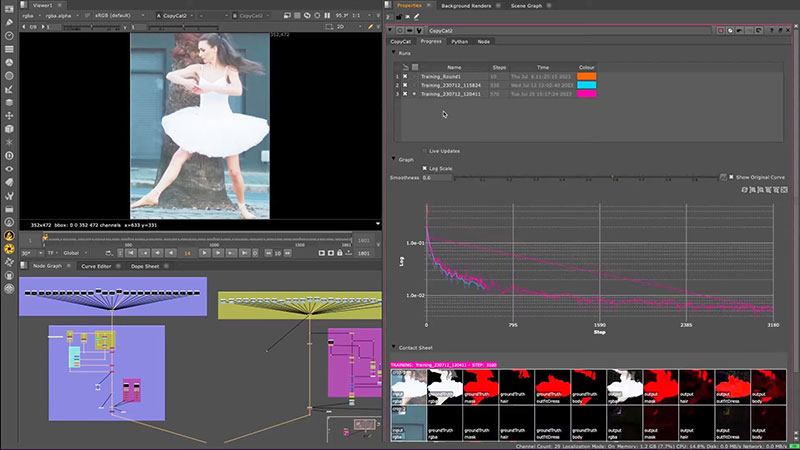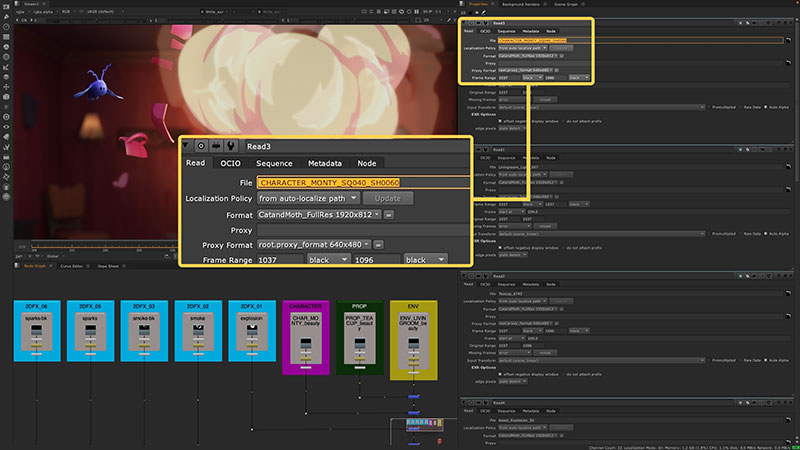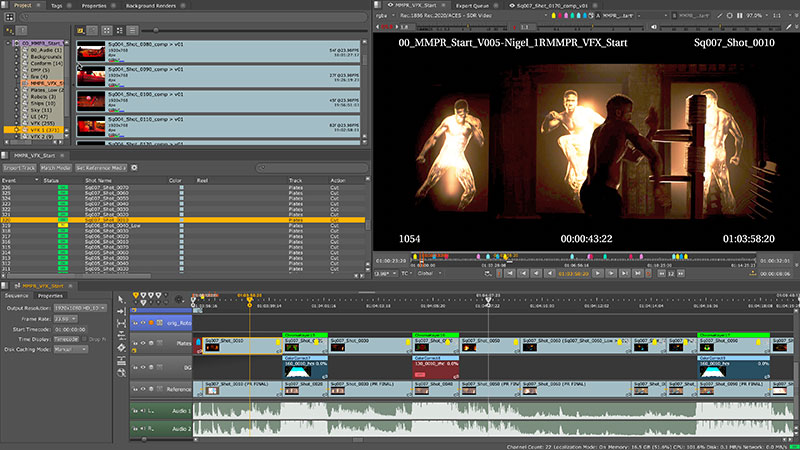Updates to Nuke 15.0 help artists iterate faster and more efficiently, due to native Apple silicon support, faster training in Nuke’s CopyCat ML tool and on-going development of the USD-based 3D system.

Faster CopyCat ML training.
Updates to Nuke 15.0, now released, help artists iterate faster and work more efficiently, due partly to higher processing speeds resulting from native Apple silicon support, as well as to faster training in Nuke’s CopyCat ML tool and the on-going development of the USD-based 3D system.
Foundry is making dual updated releases of Nuke available – versions 15.0 and 14.1 – so that the new features can be used in production immediately while users update their pipelines against the newer Linux releases. In other words, Nuke 15.0 and 14.1 will have nearly identical features, but their VFX Reference Platform support is different.
CopyCat now supports distributed training which shares the workload across multiple machines using standard render farm applications. Doing this speeds up training almost two-fold and also means users can carry on working in Nuke with CopyCat running in the background. To train with images at multiple resolutions, CopyCat will now compress images to help reduce file size during the early stages and increase training speeds.
High-resolution support is extended for users working on installations such as large events, theme park rides, and in virtual production. With sufficient hardware, Nuke now supports planar operations on images up to 64K, meaning that for Nuke 15.0 and 14.1, all CaraVR nodes, Spherical Transforms and Lens Distortions can now be used at larger resolutions, allowing greater scalability in projects.
USD-based 3D System
USD-based 3D system improvements, with USD updated to version 23.05, that are now in beta include ScanlineRender2 developments. These intend to lay the groundwork for the future of 3D rendering in Nuke, but still support rendering of existing utility passes with a familiar render experience. The UI has a more intuitive design, and a new raytracing subsystem has improved shadows with raytrace occlusion.

A technology preview of OpenAssetIO is included in Nuke 15.0 and 14.1 to support pipeline integration.
A new 3D viewer selection process, with a dedicated 3D toolbar and two-tier selections, allows more control when working with much larger stages within the 3D system. The 3D toolbar switches between object, face or vertex mode, and the new controls allow specifying a selection based on the type or kind of primitives in the scene, controlling the level at which a selection is made on a piece of geometry. A two-tier selection is contained within the user’s geometry, making it easier to focus on one item in a stage.
The larger, more complex scenes supported in Nuke 14.0’s USD-based 3D system brought the ability to work with more data and assets. The new SceneGraph popup now helps filter through the 3D scene data, using the Mask knob to inspect, filter and select cameras and primitives in the context of the scene’s hierarchy. Searching for assets is less time-consuming, and a search and filter feature is also included on the main 3D scene graph for navigation.
The updated GeoMerge node allows greater control when merging geometry and USD layers and now has four new modes – Merge Layers, Duplicate Prims, Flatten Layers and Flatten to Single Layer – and a UI designed for a more intuitive experience. These modes will support merging branching pipes, duplication workflows, controlling how layers are managed, and so on.
Timeline Tools
Users can now apply Blink effects, such as LensDistortion and Denoise at the timeline level in Nuke Studio and Hiero, without moving back and forth between the timeline and compositing environments. Blink scripting is a Nuke framework used to write code, in a manner similar to C++, to modify and process data in order to output a particular result. Because the new BlinkScript allows computing more than one pixel at a time, users can write their own complex effects to perform operations on the timeline.
![]()
Applying Blink effects at timeline level.
Similarly, with Machine Learning Inference in the timeline, CopyCat users can audition and apply effects across multiple shots at once during conform and review. You can apply pre-trained .cat files to shots or sequences directly and review the results across multiple shots in context, again, without alternating between the timeline and comp environments.
To make Nuke Studio timeline review sessions faster and more responsive, shots under the playhead are automatically selected, which means multiple actions can be applied quickly, without having to select individual shots. The new multiple-playhead also enables comparisons between different frames on the timeline much faster than before.
Furthermore, Nuke Studio and Hiero can automatically re-cache frames as they are updated. Regardless of the number and complexity of the timeline effects, users can continue reviewing while Nuke automatically refreshes the disk cache in the background.
Standards Support for Pipelines
Nuke 15.0 supports various industry standards including compliance with VFX Reference Platform 2023. Foundry is currently testing its upcoming releases on Rocky Linux 9.1, with testing on matching versions of AlmaLinux and RHEL (Red Hat Enterprise Linux). However, as mentioned above, Foundry is making dual releases of Nuke available, so that the latest features can be used in production now, while studios update their pipelines in line with new Linux releases.

Timeline review session, Nuke Studio.
OCIO (OpenColorIO) version 2.2 updates in Nuke 15.0 help users maintain colour consistency across the pipeline. To align with OCIO version 2, the Write node and Export dialogue for Nuke Studio has a labelled Output Transform subsection as a straightforward method of baking in display transforms. The new OCIO Aliases attribute allows configs, which define the colour spaces available at runtime, to also define a set of alternate names for a colour space. Nuke 15.0 includes OCIO version 2.2, which adds support for OCIOZ configs (.ocioz rchive files) to be used directly in projects.
A technology preview – not fully supported, complete or suitable for production – of OpenAssetIO is included in Nuke 15.0 and 14.1 to support pipeline integration efforts and make workflows simpler. Managed by the Academy Software Foundation, OpenAssetIO is an open-source interoperability standard for tools and content management systems. It was made to simplify asset and version management, making it easier for artists to locate and identify the assets they need.
File format support in Nuke 15.0 is updated to cover a range of supported cameras, monitor out cards and file formats. For example, support for the new ARRI Alexa 35 camera now has the ability to read files in HDE format, plus an update to the HDE SDK to version 4.0.3.
This announcement of the release of Nuke 15.0 comes ahead of the upcoming Katana 7.0 and Mari 7.0 versions. USD improvements in Katana 7.0 will have artists manipulating scenes on the same architecture as Nuke’s new 3D system, and Mari 7.0 has new baking tools that create geometry-based maps without going through a separate application. www.foundry.com


